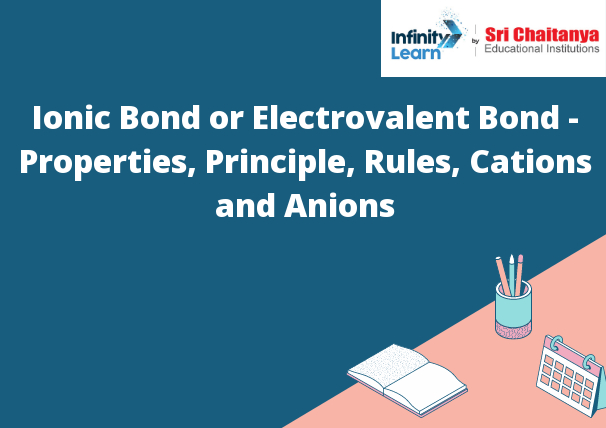Table of Contents
What is Ionic Bond or Electrovalent Bond?
Ionic Bond or Electrovalent Bond: Ionic bond is a type of chemical bond formed between two atoms by the transfer of one or more electrons from one atom to the other. This type of bond is also called an electrovalent bond. In an ionic bond, the atoms become ions, with one atom becoming positively charged and the other atom becoming negatively charged.

What are Electrovalent Compounds?
Electrovalent compounds are substances that are composed of ions. The ions are held together by electrostatic forces. The positive ions are attracted to the negative ions and vice versa. This creates a strong bond between the ions.
What are the properties of Ionic or Electrovalent Compounds?
Ionic compounds are substances composed of ions. The ions are atoms or molecules that have either gained or lost one or more electrons, and as a result, have a positive or negative charge. Ionic compounds are held together by electrostatic forces, and they typically have a high melting point and are very soluble in water.
What is the Principle of Ionic or Electrovalent Compounds Formation?
The principle of ionic or electrovalent compounds formation is that atoms or molecules gain or lose electrons in order to become ions. Ionic compounds are formed when positively charged ions (cations) and negatively charged ions (anions) come together to form a stable molecule. Electrovalent compounds are formed when atoms share electrons in a covalent bond.
Rules
What is the Duplet rule?
The Duplet rule is a mathematical principle that states that in any given set of numbers, the sum of any two adjacent numbers will be a multiple of two.
What is the Octet Rule?
The octet rule is a chemical rule of thumb that states that atoms of elements in a molecule desire to have eight electrons in their valence shell.
What are Cations and Anions?
Cations are positively charged ions and anions are negatively charged ions.
What are the differences between Electrovalent Compounds and Covalent Compounds?
In electrovalent compounds, the atoms are held together by ionic bonds. In covalent compounds, the atoms are held together by covalent bonds.
What are Oxidation and Reduction?
Oxidation and reduction are two chemical processes that are always happening simultaneously in a cell. Oxidation is the process of losing electrons, and reduction is the process of gaining electrons.
Ionic Bond or Electrovalent Bond Definition & Example
- A bond that results from the electrostatic attraction between oppositely charged ions.
- An example of an ionic bond is the bond between sodium and chloride ions.
Properties
The following table lists the properties of the class.
Principle of Ionic Compound Formation and Rules
Ionic compounds are composed of positive ions (cations) and negative ions (anions). The compound is formed when the cations and anions come together and exchange electrons until they have a full outer shell.
The following are general rules for the formation of ionic compounds:
1. The cation is always the positive ion.
2. The anion is always the negative ion.
3. The cation and anion must have opposite charges.
4. The cation and anion must have the same element but with a different charge.
5. The cation and anion must have the same number of protons but with a different number of neutrons.
Cations and Anions
Cations are atoms or molecules that have a net positive charge due to the loss of one or more electrons. Anions are atoms or molecules that have a net negative charge due to the gain of one or more electrons.
Differences between Covalent and Electrovalent Compounds
There are several key differences between covalent and electrovalent compounds.
- The first is that covalent compounds are held together by shared electrons, while electrovalent compounds are held together by electrostatic attraction between positive and negative ions. This means that covalent compounds are generally more stable than electrovalent compounds.
- Another difference is that covalent compounds are typically non-polar, while electrovalent compounds are typically polar. This means that covalent compounds are generally less soluble in water than electrovalent compounds.
- Finally, covalent compounds are typically less reactive than electrovalent compounds.









